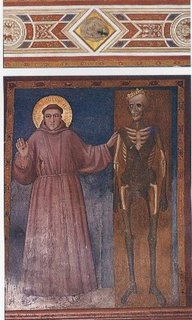 The inter-religious dialogue in Assisi and the Ecumenical movement are the Church's sincere attempt to bring all religions into, at least, mutual tolerance, with its proximate goal to be an occassion for the working of Actual grace. Their ultimate end: openness and surrender to the truth. No, there is no ambition to unite, to borrow, or share teachings and practices, no attempts at a common denominator.
The inter-religious dialogue in Assisi and the Ecumenical movement are the Church's sincere attempt to bring all religions into, at least, mutual tolerance, with its proximate goal to be an occassion for the working of Actual grace. Their ultimate end: openness and surrender to the truth. No, there is no ambition to unite, to borrow, or share teachings and practices, no attempts at a common denominator.Cardinal Newman, Gilbert Chesterton, Baring, Ratisbonne and Edith Stein were converts to the Catholic faith and became great assets to the Church at the time when inter-religious dialogues were not popular.
We believe that there is a God, and that He spoke; and what He said is Divine Revelation. This Divine Revelation is impossible to mix, or to find a common ground, with other religions. To attempt to do so would be like mixing oil and water. A general tendency has been noticed since the start of the misinterpretation of Vatican ll: some have tried applying bodily postures with attempts to reach Christian contemplation. Contemplation is a Divine activity. There is nothing outside Christianity that one can mix with it in order to attain or enhance it, nor can Christianity benefit other religions unless it is taken in its purity, without additives. And so, if, as many think, the aim of the inter-religious dialogue in Assisi is to mix the varied beliefs into a cocktail acceptable to all, or come to a common denominator, they are wrong. This is not the goal of the Assisi meeting, but that is the impression many are getting.
But if we let the inter-religious dialogue work on the concept of Actual Grace, it has a great chance to succeed according to the purpose for which it was conceived by Pope John Paul ll. And it can only succeed because of Actual Grace. Of course we know that anybody can welcome or reject this grace. But Actual Grace is a movement from God that invites a soul to repentance and conversion. It begins with repentance wherein a soul realizes his sinfulness and can go further into the soul desiring the forgiveness of his sins through conversion. Then God shows the next step after conversion, which is the way to the true Church. And the usual instrument used by God to bestow this grace is through the preaching of one sent by Him.
Only through such preachers, those sent by God like the Pope, the successor of Peter who was an apostle and therefore sent by God, or at least someone like St. Francis de Sales, or St. John Vianney, will God give Actual Grace to the listeners. Though the hearers are free to reject or harden their hearts against this grace, yet this is the only hope for any good to come out of the inter-religious dialogues. Without this, everything is futile.
Actual Grace is given to all in order to find the truth. But when it is rejected it is withdrawn. Only a true repentance will make God restore it. Many don't even notice when they reject it. Grace is withdrawn and unless God restore it, there is no possibility of conversion, unless - - some contemplative souls earnestly beg God, as St. Therese begged for the grace of repentance for the criminal Franzini. The criminal did nothing to deserve the grace. He was blaspheming. He deserved perdition, but it was the prayers of St. Therese who pitied that soul that made God restore to him Actual Grace. Actual Grace became Efficacious Grace, as shown by the instant conversion of the criminal, just as we have seen happen to Demas the good thief hanging on the cross beside Christ. They did something that transformed Actual into Efficacious Grace; something we, and all participants in the inter-faith dialogues in Assisi, must do, too.
If Pope Benedict is continuing what seems to be futile at first sight, it is because of his belief in the theology of grace. After all, a million Aztecs were converted to Christianity without much help from preachers: God used a picture of our Lady as His intrument to bestow Actual Graces. Most of the great converts to the Catholic faith never attended any inter-religious gatherings.
The first visible movement towards conversion is tolerance, when we find the other religions tolerable. Tolerance directs us to the true religion. This is followed by the fear that the attraction to it is too strong and, finally, the fear of finding the need to enter into that true faith. All these steps are choreographed by Actual Graces or Sufficient Graces. Nothing is human or psychological in the process.
If this is the case, then the Pope speaking on Vatican radio or on TV, or writing an encyclical would be sufficient. Actual Graces will take over. Everything else is pure courtesy.
(Painting is "St. Francis with the stigmata raising his right hand in sign of welcome and laying his left hand on friend and sister death from whom no living man can flee, by Giotto.)